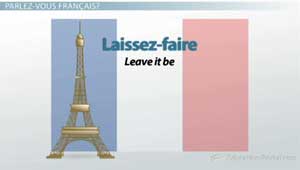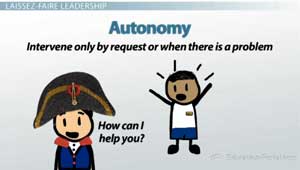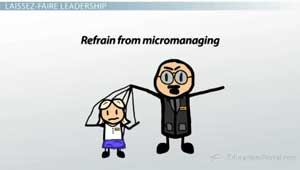The Laissez-faire Leader - Quiz
Choose your answer and write the correct one down. Then click HERE for the answers to this quiz.
NOTE: The transcript from the video is listed below the quiz for your reference.
1. What characteristics are necessary in employees for the laissez-faire leadership style to be effective?
- Knowledgeable
- Experienced
- Self-starter
- All of these
-
Competent
2. At which point will the laissez-faire leader intervene in an employee's work?
- At the employee's request
- When the boss tells him or her to do so
- The laizzez-faire leader never intervenes
- At a peer's request
- When he or she wants to micromanage the employee
3. The laissez-faire leader provides their employee with which of the following?
- Autonomy
- Freedom to set their own deadlines
- Regular feedback
- All of these
- All of the resources they need
4. Which of these statements is true of the laissez-faire leader?
- The laissez-faire leader does not monitor his or her employees on a regular basis
- The laissez-faire leader does monitor his or her employees on a regular basis
- The laissez-faire leader allows peers to monitor employees on a regular basis
- The laissez-faire leader monitors his or her employees on an annual basis
- The laissez-faire leader allows the employee to self-monitor on a regular basis
5. Laissez-faire is a French phrase that translates into:
- Leave me alone
- Leave it be
- Laziness
- Micromanager
- Do as I say
This lesson describes the characteristics of the laissez-faire leader. Learn the characteristic style of this type of leader and what to expect from this leadership style.
Parlez-vous français?
French fries, French kiss, French braid, French toast, French door, French dressing, French manicure...while these phrases might be as close to speaking French that you will ever get, one actual French phrase that you should know that relates to management is laissez-faire, or leave it be.
 |
Laissez-faire Leadership
French lessons aside, when placed into the context of leadership, the term laissez-faire depicts a leader who allows subordinates to work on their own. The laissez-faire leader is the opposite of autocratic leadership, where people have complete control over their employees, much like a micromanager. Laissez-faire leaders offer their subordinates autonomy, providing them with all of the resources and information they need to do their jobs and intervene only by request or when there is a problem.
 |
Effective laissez-faire leaders understand that while they can practice a more hands-off approach to leadership they still have a high level of responsibility to their followers. The effective laissez-faire leader still monitors the performance of their employees and provides them with feedback on a regular basis. They simply refrain from micromanaging them.
 |
Leon the Laissez-faire Leader
To better understand laissez-faire leadership, let's take a look at this example.
Leon is a laissez-faire leader, and he's in charge of the daily operations at his family's winery. As a laissez-faire leader, Leon prefers to allow his employees to manage themselves. The laissez-faire style of leadership is most fitting for Leon because he runs a family business, so the majority of the workers are either family or have worked at the winery for an extended period of time. Leon knows each of the employees are skilled and knowledgeable enough to handle their responsibilities on their own. Leon only needs to check with his staff periodically to make sure that they are maintaining a high level of productivity in whatever tasks they are responsible for at the winery.
 |
Leon is confident that the laissez-faire leadership style works well for his family's business because he is able to provide each employee with a high level of autonomy resulting in an increased level of job satisfaction in employees, making his winery a place where the staff enjoy coming to their jobs each day and are ready to do whatever it takes to help the winery be a successful business.
 |
Lesson Summary
Let's review. Laissez-faire is a French phrase which translates into leave it be. When placed into the context of leadership, it depicts a leader who allows subordinates to work on their own. The laissez-faire leader is the opposite of an autocratic leader in that the laissez-faire leader offers their subordinates autonomy, providing them with all the resources and information they need to do their jobs, intervening only by request or when there is a problem. The leadership style can be intentional, promoting a high level of job satisfaction and productivity but can also be accidental at the same time. The effective laissez-faire leader doesn't just ignore their employees; rather they will monitor their performance and provide them with feedback on a regular basis. Doing so allows them to identify when subordinates lack the necessary skills, training, expertise, and motivation to effectively manage themselves.